Dry-Creek Garden
A grove of red maple trees provides ample shade for a variety of perennials as you enter the Dry-Creek Garden.
Overview of Dry-Creek Garden
A grove of red maple trees provides ample shade for a variety of perennials as you enter the Dry-Creek Garden. The Dry-Creek was added in 2014 when a necessary trail-widening project was undertaken to accommodate the ever-increasing numbers of guests that visit the Botanical Gardens at the Creation Museum. Tucked under the maple trees, you will find another Buddy Davis Dinosaur sculpture peering out through the maple leaves and ornamental grasses that surround it. As you follow along the Dry-Creek with a view of the different ornamental plant varieties, you will encounter flowering dogwood trees. This larger dogwood holds its flower longer than some other dogwood varieties. These possible variations within the same plant family are another example of the unsearchable greatness of God in all his creation!

Sun Valley Red Maple
Common Name: Sun Valley Red Maple
Botanical Name: Acer rubrum
Height: 30–50 feet
Spread: 15–40 feet
Location: Full sun to part shade
Bloom: March, red flower
Hardiness zone 4–7
Sun Valley is a U.S. National Arboretum introduction and is one of many red maple varieties. It typically has an oval crown or top with 4 four-inch-long and wide leaves that turn an exceptional red color in the fall. This tree is also known to be more resistant to leafhopper bugs than some other types.

Heritage River Birch
Common Name: Heritage River Birch
Botanical Name: Betula nigra
Height: 40–75 feet
Spread: 40–60 feet
Location: Full sun to part shade
Bloom: April to May, brown and green catkins
Hardiness zone 4–9
The Heritage series of birch tree can be used as a single specimen, in a hedge row, or in a grove like we have beside the Grand Staircase and the Café restaurant. This tree works great with most styles of architecture so it should fit well into your landscape. The light, peeling bark will give you year-round interest which makes this a popular four-season plant.
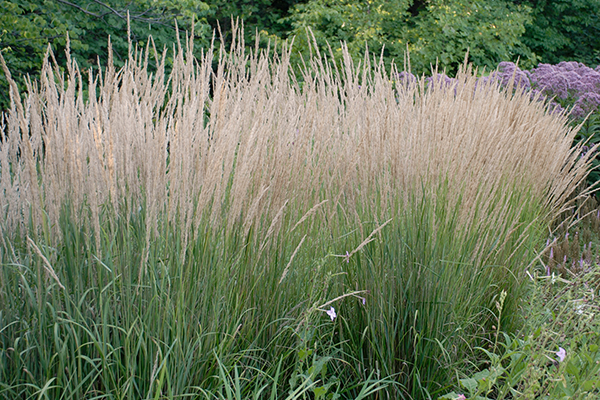
Karl Foerster Reed Grass
Common Name: Karl Foerster Reed Grass
Botanical Name: Calamagrostis acutiflora
Height: 3–6 feet
Spread: 1.5–3 feet
Location: Full sun to part shade
Bloom: May to February, Pinkish-purple flower plumes
Hardiness zone 5–11
Karl Foerster is a past “Perennial of the Year” award-winning reed grass that has an upright, ridged growing habit. This hybrid grass also performs well in a variety of soil types and sun exposures producing narrow flower plumes. The plumes can rise to 5 feet dwarfing the grass leaves and are followed by golden seeds that persist well into the winter for seasonal interest.

Eastern Redbud
Common Name: Eastern Redbud
Botanical Name: Cercis canadensis
Height: 20–30 feet
Spread: 25–35 feet
Location: Full sun to part shade
Bloom: April, pink flowers
Hardiness zone 4–9
There are many hybrid Redbud trees all having unique characteristics. The standard Eastern Redbud that you see in tree lines, fence rows, and in the woodlands of the eastern U.S. still stands as a remarkably attractive native tree and is still available in commerce. It is very adaptable to a variety of conditions and consistently produces the pink flowers seen for miles in early spring before the leaves emerge making it a carefree choice for most gardens.

Presto Tickseed
Common Name: Presto Tickseed
Botanical Name: Coreopsis grandiflora
Height: 6–10 inches
Spread: 6–12 inches
Location: Full sun to part shade
Bloom: May to August, yellow flower
Hardiness zone 4–9
Presto is a large flowering tickseed native to southeastern U.S. and found in open grounds, thickets, and roadsides. It typically grows into 2-foot clumps but can spread by self-seeding and by rhizomes if not pruned. The flowers are yellow, 2 to 3-inch daisy like and appear on a single stem. Presto will bloom in late spring and could last into the fall season if removal of the spent flowers occurs on a regular basis.

Aurora Dogwood
Common Name: Aurora Dogwood
Botanical Name: Cornus rutban
Height: 14–30 feet
Spread: 14–25 feet
Location: Full sun to part shade
Bloom: April to May, white flowers
Hardiness zone 5–9
Aurora Dogwood is a hybrid developed by Rutgers University as part of a series of dogwood trails. It is noted as a very vigorous, upright growing tree that is more resistant to disease and insects than some of the other dogwood varieties. The main difference between the Aurora hybrid and a non-hybrid dogwood is that the leaves and flowers appear together rather than the flowers first and then the leaves. The flowers are large and white normally appearing in abundance adding drama to our Dry-Creek Garden and to your garden if you plant one. The leaves are dark green lasting through the season then turning a purple-red color for the fall.

Magnus Coneflower
Common Name: Magnus Coneflower
Botanical Name: Echinacea purpurea
Height: 2.5–4 feet
Spread: 1–12 feet
Location: Full sun to part shade
Bloom: June to August, purple flower
Hardiness zone 3–9
A popular perennial with long lasting flowers commonly called purple coneflower. Often mass planted in a border or wildflower garden but you can plant one, three, or five in a smaller garden to attract butterflies and hummingbirds. If you leave the stem and spent flower on in the winter, it will provide another food source for some birds and then prune what is left to the ground in the spring.
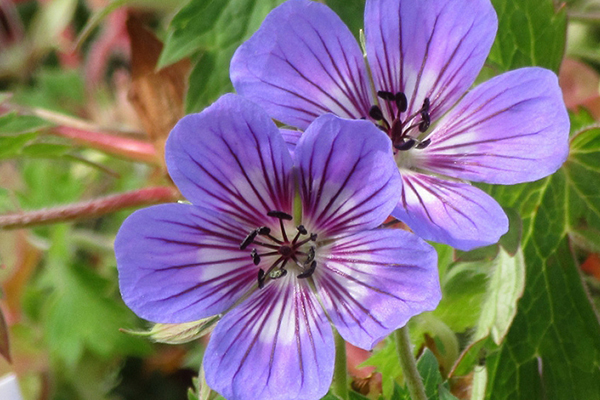
Havana Blues Cranesbill
Common Name: Havana Blues Cranesbill
Botanical Name: Geranium wallichianum
Height: 1–2 feet
Spread: 1–3 feet
Location: Full sun to part shade
Bloom: June to August, lavender-blue flowers
Hardiness zone 5–9
Havana Blues provides long lasting, flowering color through the summer until the first frost. The deep taproot makes it very drought resistant, although it will perform better in medium moisture and in well-drained soil. It is a perennial plant so it will come back year after year with minimal care required. The outwardly spreading branches hold green 3 to 5 lobed leaves that turn red in the fall.
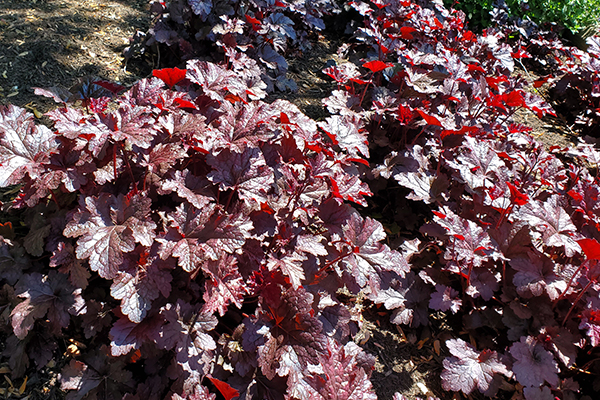
Palace Purple Coral Bells
Common Name: Palace Purple Coral Bells
Botanical Name: Heuchera micrantha diversifolia
Height: 1–2 feet
Spread: 1–2 feet
Location: Full sun to part shade
Bloom: June to July, white flower
Hardiness zone 4–9
The very large, purple/bronze star-shaped leaf is one characteristic that makes this award winner in the Heuchera family very popular with many gardeners. This is a perennial plant so it will come back for you every year. It is easy to grow and requires little maintenance. It will look great along a border, in your rock garden, or in a planter. In late spring, there are groups of small, bell-shaped, white flowers on 20” high stems giving great contrast to the foliage.
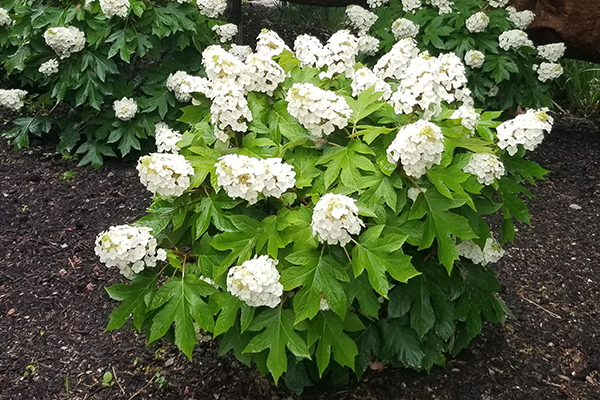
Little Munchkin Oakleaf Hydrangea
Common Name: Little Munchkin Oakleaf Hydrangea
Botanical Name: Hydrangea quercifolia
Height: 3–4.5 feet
Spread: 3–5.5 feet
Location: Full sun to part shade
Bloom: June to July, white turning pink flower
Hardiness zone 5–9
Little Munchkin grows 3 to 4.5 feet tall and requires very little effort to receive all the horticultural benefits from this magnificent dwarf hydrangea. It is a 2010 hybrid introduction from the U.S. Arboretum breeding program now available in commerce. The dark green foliage provides a backdrop for the white 6 to 7-inch pyramidal shaped flowers that turn light pink then to brown in the fall. The foliage turns a mahogany red in the fall holding into the winter.
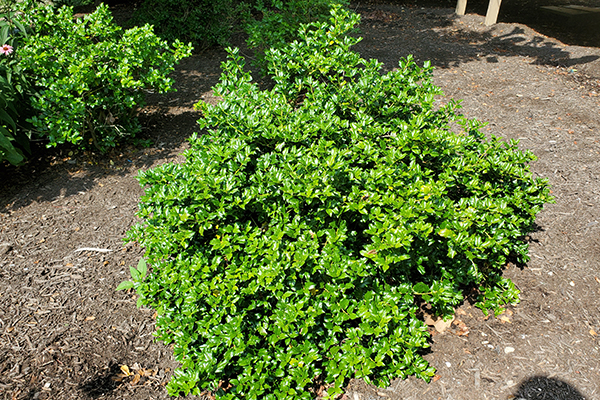
China Girl Holly
Common Name: China Girl Holly
Botanical Name: Ilex mesog
Height: 7–14 feet
Spread: 5–10 feet
Location: Full sun to part shade
Bloom: April to May, White flower
Hardiness zone 4–9
China Girl is a popular evergreen shrub that has a very dense and rounded growth habit. Shiny, dark green leaves stay on the plant year-round making it a great foundational plant for any landscape. Red berries appear in the fall and persist into the winter adding seasonal color. China Holly is dioecious which means that you will also need to plant a China Boy as a pollinator to have the berries on the China Girl. One China Boy will usually pollinate most residential sized landscapes. This is a hardy, disease resistant plant, but you will need to watch for some unwanted insects including scale and treat as needed.

Caesar's Brother Siberian Iris
Common Name: Caesar's Brother Siberian Iris
Botanical Name: Iris sibirica
Height: 3–4 feet
Spread: 1–2 feet
Location: Full sun to part shade
Bloom: May, purple flower
Hardiness zone 2–9
Iris is an easy to grow aquatic marginal, but it can become invasive if not cared for properly. We have this plant in several gardens and it always performs well under various conditions. The dark purple bloom is a showstopper and contrasts well with many other colors.
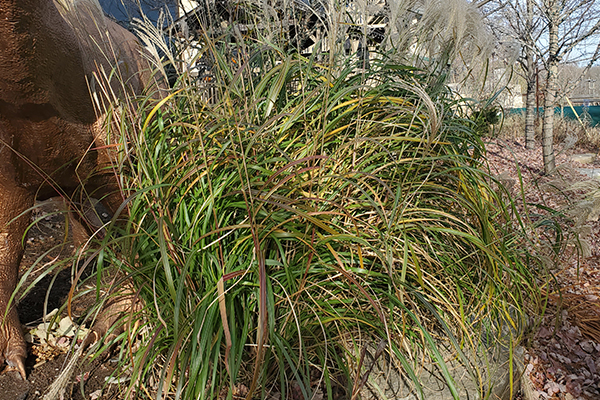
Adagio Maiden Grass
Common Name: Adagio Maiden Grass
Botanical Name: Miscanthus sinensis
Height: 3–5 feet
Spread: 3–5 feet
Location: Full sun to part shade
Bloom: August to February, white plumes
Hardiness zone 5–9
Adagio is a dwarf ornamental perennial grass only growing to 4 feet tall. It is clump forming with green foliage that turns a yellow green in the fall season. An abundance of creamy white flumes persists into winter providing more drama for your garden. Prune in early spring as temperatures begin to warm.
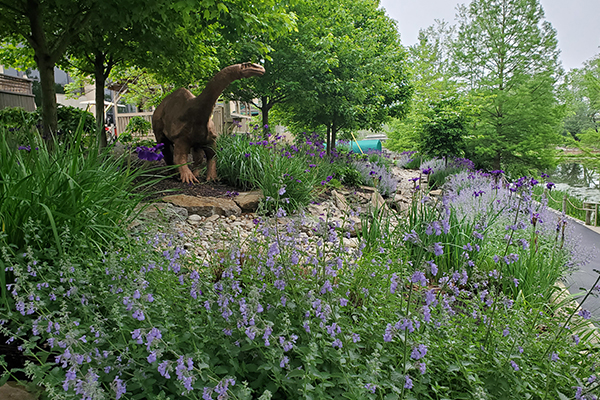
Walker's Low Catmint
Common Name: Walker's Low Catmint
Botanical Name: Nepeta racemosa faassenii
Height: 2–3 feet
Spread: 2.5–3 feet
Location: Full sun to part shade
Bloom: April to September, lavender flower
Hardiness zone 3–9
A good use for Catmint is as a border plant, as we have in the Butterfly Garden, but it can also be used as a ground cover. Walker’s Low is an award winner and was noted for its massive lavender flowers continuing to bloom into the early Fall. To encourage new blooms, remove the old spent flowers, similar to most plant varieties. Walker’s will usually spread 2 to 3 feet allowing you to cover a larger area with less plants. The seeds are sterile so you will need to propagate by division.
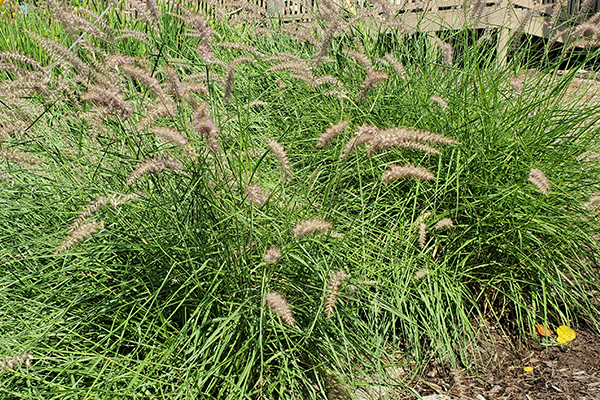
Karley Rose Fountain Grass
Common Name: Karley Rose Fountain Grass
Botanical Name: Pennisetum orientale
Height: 2–3 feet
Spread: 2–3 feet
Location: Full sun to part shade
Bloom: June to August, rose-purple plume
Hardiness zone 5–10
Karley is a warm season ornamental fountain grass that normally forms clumps of 18-inch-tall and deep green foliage that turns a yellow green in the fall. Larger and fuller purple plumes arrive in early summer and usually remain throughout winter. Karley stands out planted as a specimen or planted in a group.
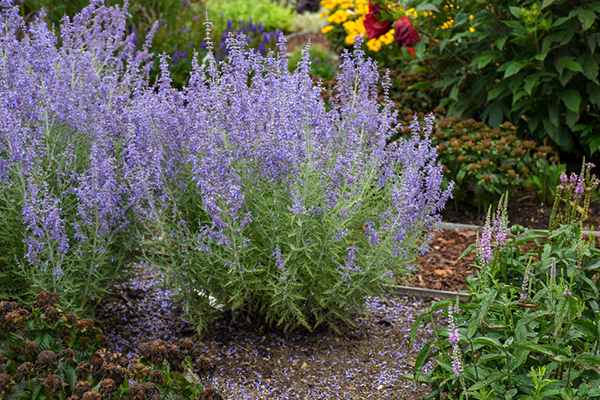
Lacey Blue Russian Sage
Common Name: Lacey Blue Russian Sage
Botanical Name: Perovskia atriplicifolia lisslitt
Height: 1.5–4 feet
Spread: 1.5–2 feet
Location: Full sun to part shade
Bloom: June to frost, lavender blue flower
Hardiness zone 4–10
Named after a Russian general, Perovskia Russian sage is a woody based perennial that comes from the mint family. It normally grows no taller than 4 feet and produces lavender blue flowers all summer long if it is planted in a full sun location. Its silver green leaves have a spicy mint like scent if crushed. Plant as a specimen or in mass adding contrast to your garden.